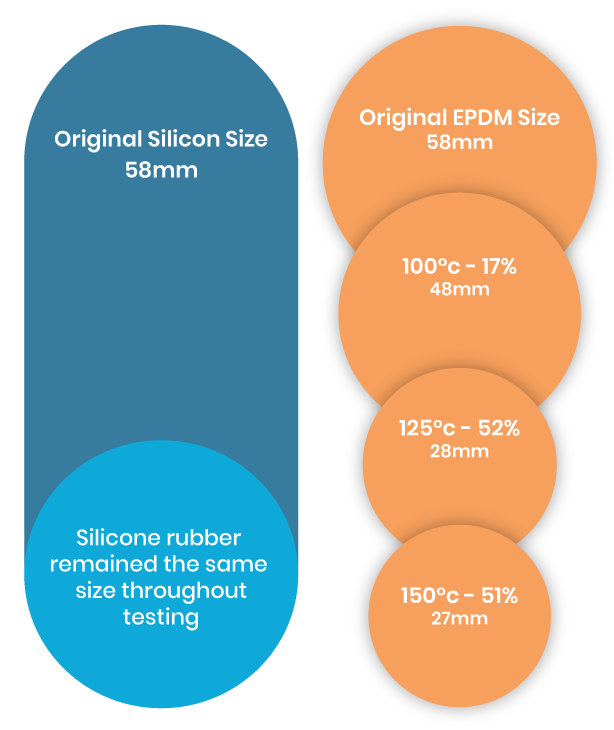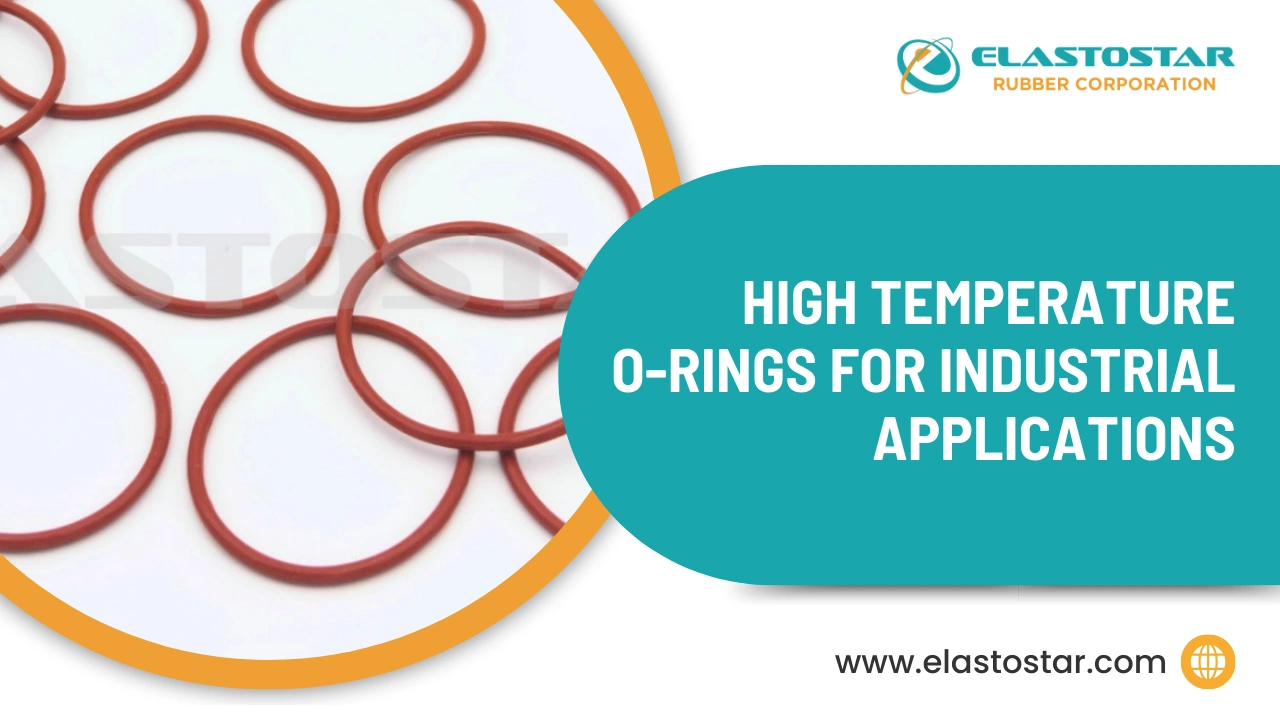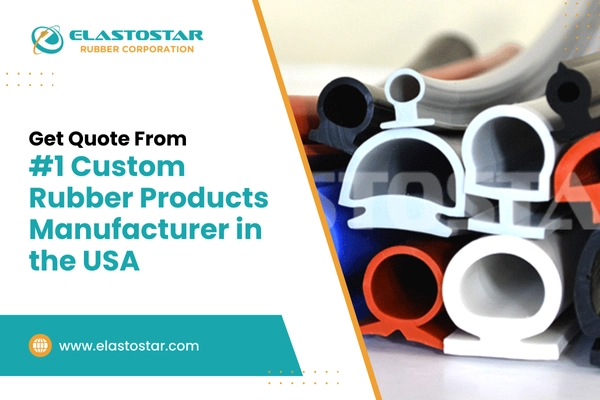EPDM and Silicone are two -excellent choices when it comes to selecting rubber materials for a wide range of applications. With the global EPDM market valued at $3.68 billion in 2020 and the silicone market expected to soar to $30.4 billion by 2028, it’s clear that both materials play a vital role across industries.-EPDM rubber material, known for its unbeatable weather resistance and durability, is the top pick for automotive seals and roofing membranes.
On the other hand, silicone rubber is well-known for its remarkable temperature resistance and flexibility, making it the go-to material for medical devices and electronics.
Choosing between these two versatile materials can be challenging, but understanding their differences is key to ensuring the success and longevity of your project. In the following sections, we’ll take a closer look at their distinct properties, explore their wide-ranging applications, and weigh the advantages each one offers, guiding you to the best choice for your specific needs.
Let’s understand the difference!
Table of Contents
What is EPDM?
EPDM (Ethylene Propylene Diene Monomer) rubber is a type of synthetic rubber known for its excellent weather resistance and durability. It is made from ethylene, propylene, and a diene comonomer, which allows it to form strong cross-links. These cross-links give EPDM rubber its great elasticity and resistance, making it a versatile and reliable material for many different uses.
What is Silicone Rubber?
Silicone rubber is a synthetic elastomer made from silicone, composed of silicon, carbon, hydrogen, and oxygen. It is highly valued for its exceptional flexibility, temperature resistance, and biocompatibility. These properties make it ideal for a wide range of applications, including medical devices, kitchenware, and electronic components. Its ability to maintain stability and performance across a broad temperature range further enhances its versatility and reliability.
Now, let’s compare Silicone and EPDM in terms of their material properties to see which one suits your needs best.
How is Silicone Manufactured?
Silicone can be manufactured in various ways based on the types of silicone being used. Silicone can come in three forms, namely LSR’s (liquid silicone rubbers) as well as RTV’s (Room Temperature Vulcanisation) and HTV’s (High-Temperature Vulcanisation).
Elastostar Rubber Corporation manufactures HTV silicone rubber. The silicone is formed into the exact shape needed before going through a heat curing process to create the final product. Silicones are produced in various kinds and shapes, such as silicone rubber sheets and rolls, tubes, cords, profiles, and sections. They can be made in solid or sponge silicone based on the application(s).
Silicone vs. EPDM Technical Comparison
To make the best material choice, it’s essential to understand the Material Properties, Applications, Advantages and Disadvantages, and Melting temperature of silicone and EPDM. As this knowledge ensures reliable and efficient performance in your applications.
1. Material Properties
Understanding the key material properties is crucial for selecting the right material for your application.
| Property | EPDM Rubber | Silicone Rubber |
| Temperature Resistance | -50°C to 150°C | -60°C to 230°C |
| Chemical Resistance | Good resistance to acids, alkalis, and phosphate esters | Excellent resistance to oils, solvents, and many chemicals |
| Durability and Longevity | High resistance to abrasion, tearing, and general wear and tear | Maintains flexibility and strength over a wide temperature range |
| Environmental Resistance | Excellent resistance to UV radiation, ozone, and extreme weather conditions | Resistant to UV radiation, ozone, and weathering, ensuring long-lasting performance |
Now that we’ve covered their material properties, let’s read the various applications.
2. Applications
Common Industries Using EPDM
- Automotive: EPDM rubber is widely used for seals, hoses, and weather stripping due to its flexibility and long-lasting performance.
- Construction: Employed in roofing membranes and window seals, it offers superior weather resistance and durability.
- HVAC: This material is ideal for rubber gaskets and insulation in heating, ventilation, and air conditioning systems because of its temperature and weather resistance.
- Electrical: Commonly used for wire and cable insulation, EPDM provides excellent electrical resistance properties.
- Agriculture: EPDM is valued in irrigation systems and sealing applications for its robustness and reliability.
Common Industries Using Silicone
- Medical: Silicone is essential for tubing, seals,extruded gaskets, and implants due to its biocompatibility.
- Food and Beverage: Used in baking industries such as baking molds, spatulas, and seals for its heat resistance and non-reactive nature.
- Electronics: This material is commonly found in keypads, insulators, and flexible circuits because of its durability and flexibility.
- Aerospace: Utilized in insulation materials for its ability to withstand extreme temperatures.
- Consumer Goods: Silicone is widely appreciated in household products like kitchenware for its safety and durability.
Having explored their applications, it’s important to weigh the pros and cons of using Silicone and EPDM for your specific needs.
3. Advantages and Disadvantages
Advantages of EPDM
- Weather Resistance: Excellent protection against UV radiation, ozone, and extreme weather, ideal for outdoor use.
- Durability: High resistance to abrasion, tearing, and water.
- Chemical Resistance: Effective against polar solvents, acids, alkalies, and phosphate esters.
- Electrical Insulation: Suitable for insulation and gaskets.
- Cost-Effective: More affordable than silicone.
- Temperature Range: Operates from -50°C to 150°C, suitable for high temperature gaskets.
While EPDM has many advantages, it also comes with some limitations.
- Chemical Limitations: Not compatible with oils, greases, and hydrocarbon fuels.
- Temperature Performance: Limited high-temperature resistance compared to silicone.
- Flexibility: Less flexible and has a shorter life span, requiring more frequent replacements.
Advantages of Silicone
- Temperature Resistance: Silicone excels in extreme temperatures, maintaining flexibility and strength from -60°C to 230°C, with a melting point of around 232°C (450°F).
- Biocompatibility: Non-toxic and hypoallergenic, making it suitable for medical and food-grade applications.
- Chemical Resistance: Excellent resistance to oils, solvents, brake fluids, and many chemicals, ensuring durability in harsh environments.
- Durability: Highly resistant to UV radiation, ozone, and weathering, making silicone rubber ideal for outdoor and long-term use.
- Compression: Maintains shape under pressure, ensuring reliability in sealing applications.
- Versatility: Can be modified for various applications, offering flexibility in design and use.
However, silicone rubber also has some disadvantages to consider.
- Cost: Generally more expensive than EPDM, which can impact budgeting for large-scale projects.
- Abrasion Resistance: Poor resistance to abrasion, though this can be improved with specific formulations.
- Water Swell Resistance: Generally poor, although modifications can enhance performance.
- Steam and Chemical Limitations: Should not be used with steam over 121°C (249°F) or with hydrocarbon fuels, alkalis, acids, trichloroethylene, and aromatic hydrocarbons.
4. Highest Melting Point
When it comes to selecting rubber materials for industrial applications, understanding the temperature resilience of different types is crucial.
Silicone Rubber
Silicone rubber can endure temperatures from -60°C to 230°C, maintaining flexibility and performance even under prolonged heat exposure. This makes it ideal for high-temperature applications like medical devices, electronics, and automotive parts.
EPDM Rubber
EPDM (ethylene propylene rubber) handles temperatures from -50°C to 150°C. While it performs well in many applications, it may degrade at higher temperatures. EPDM is best suited for outdoor and automotive uses where resistance to weathering is more important than extreme heat tolerance.
How Heat Affects Silicone vs. EPDM
As shown in the diagram, silicone rubber and EPDM vary when exposed to different degrees of heat.
Our Laboratory team carried out several tests of heat age using a standard silicone sponge and a regular EPDM sponge. Both had a thickness of 6mm.
Six circles measuring 58mm were cut out of the original pieces and placed in the oven for a few hours at various temperatures. The outcomes were then documented in the following manner:

EPDM Results
At 100°C, the EPDM sample had shrunk by 17% to 48mm. A surprising result considering that the datasheet indicated the temperature limit was 130°C.
At 125°C the shrinkage continued, but it was more severe, showing a 52% decrease from its original size to 28mm.
Finally, at 150°C the EPDM had decreased but only by a further 1mm, concluding that 125°C is where the material saw severe deformity.
Silicone Results
The silicone samples did not show any shrinkage when exposed to the same temperature as EPDM. The silicone rubber samples all remained at 58mm after being taken out from the oven, demonstrating the strength of silicone when heated to high temperatures.
Why Choosing the Right Material is Important?
When choosing between silicone and EPDM, it’s important to consider their distinct properties and application needs.
- Silicone is highly flexible, biocompatible, and excels in medical, food-grade, and electronic applications. With excellent resistance to chemicals and weathering, silicone is durable but comes at a higher cost and with less abrasion resistance.
- EPDM, on the other hand, is known for its superior weather resistance, durability, and cost-effectiveness. It’s the most water-resistant rubber, making it ideal for outdoor, automotive, and construction applications. However, EPDM isn’t suited for applications involving oils and greases and has a shorter lifespan than silicone.
At Elastostar, we offer both silicone and EPDM options, and our team can guide you in choosing the best material for your specific needs. Whether you’re looking for a durable, cost-effective solution or a material that excels in demanding environments, we’re here to help you make the right choice and ensure your purchase meets all your requirements.
Tips- Choose silicone for high heat and chemical resistance, and EPDM for weather resistance and affordability.
Looking for alternatives? Uncover other high-performance rubber materials that might be the perfect fit for your unique needs beyond silicone and EPDM.
What is alternative Materials to Silicone and EPDM
Here are a few alternative materials to Silicone and EPDM;
- Neoprene Rubber: Offers a good balance of oil, chemical, and weather resistance. It’s versatile and cost-effective, widely used in automotive, marine, and industrial applications.
- Nitrile Rubber (NBR): Known for excellent oil and fuel resistance, making it ideal for automotive and aeronautical industries. It’s highly durable and suited for harsh environments.
- Fluoroelastomer (FKM/Viton): Exceptional resistance to high temperatures, chemicals, and oils. Commonly used in aerospace, automotive, and industrial applications requiring extreme durability.

Conclusion
Selecting between EPDM and silicone rubber depends on your specific needs. EPDM is renowned for its weather resistance and affordability, making it suitable for outdoor and automotive applications. Silicone rubber offers superior temperature resistance and flexibility, ideal for high-heat and specialized uses. For customized extruded rubber solutions and expert advice, you can get in touch with Elastostar Rubber Corporation. We provide a wide range of high-quality rubber profiles – to ensure optimal performance and durability for your projects.
Elastostar is proud to offer the highest quality components and rubber parts in the industry. We have been a trusted manufacturer of custom and standard size extruded rubber seal and gaskets parts for the food equipment, medical, pharmaceutical, industries, Glass, window& door industries.
Our advanced facilities and experienced experts can create FDA medical, medical and surgical-grade tubing and other top-quality products. All the products are made of various rubber-based materials, including silicon rubber. To find out more about our top Silicone Rubber products and solutions, please get in touch with us now or request a quote today or call us on +1 614-841-4400.
FAQS
What are the key differences between EPDM and Silicone?
EPDM rubber excels in weather resistance and UV stability, while silicone offers better heat resistance and durability.
Which is better for outdoor applications, EPDM or Silicone?
For outdoor applications, EPDM is generally better due to its superior resistance to UV rays and ozone, making it ideal for prolonged exposure to the elements. If you need a reliable solution for your outdoor applications, Elastostar can provide customized EPDM products to meet your specific needs. Feel free to contact us for expert advice and high-quality rubber solutions.
Can EPDM and Silicone be used interchangeably?
No, EPDM and silicone are not usually interchangeable due to their distinct properties. EPDM is ideal for weather resistance, while silicone is better suited for high-temperature environments.
What are the cost implications of choosing Silicone over EPDM?
Yes, choosing silicone over EPDM can result in higher costs, primarily due to its superior heat resistance and rubber melting point.




